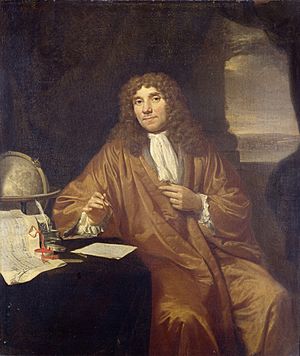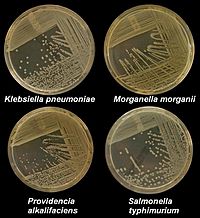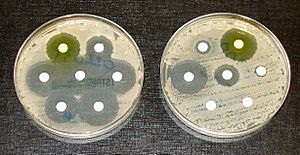Medical microbiology facts for kids


Medical microbiology, also known as ‘’’clinical microbiology’’’, is the study of microbes, such as bacteria, viruses, fungi and parasites, which cause a human illness and their role in the disease.
The microbes and the branch of microbiology are the most studied due to their great importance to medicine.
Medical microbiology studies development and progress of the infectious disease in a patient and in human population (epidemiology). It is related to the study of disease pathology and immunology. It is a branch of medicine and microbiology and includes five sciences: bacteriology, virology, parasitology, immunology and mycology.
History of medical microbiology
In 1546, Girolamo Fracastoro proposed that epidemic diseases were caused by transferable seed like entities through direct, indirect contact and contact over long distances with an infection.
Louis Pasteur and Robert Koch are the founders of medical microbiology. Louis Pasteur is famous for his experiments when he disproved the theory of spontaneous generation. He offered method for food preservation (pasteurization) and vaccines against anthrax, fowl cholera and rabies. Robert Koch contributed to the germ theory of disease, provided that specific diseases were caused by specific microbes. He developed criteria known as the Koch's postulates and was among first to isolate bacteria in pure culture resulting in his description of several bacteria including Mycobacterium tuberculosis, the causative agent of tuberculosis.
Fields in medical microbiology
- Microbial physiology is the study of microbial growth, microbial metabolism and microbial cell structure.
- Microbial genetics is the study of how genes are organized and regulated in microbes in relation to their cellular functions.
- Parasitology investigates parasites. The specimen here is feces, blood, urine, sputum, and other samples.
- Virology identifies viruses in specimens of blood, urine, and cerebrospinal fluid.
- Immunology/Serology uses antigen-antibody interaction as a diagnostic tool, determines compatibility of transplanted organs.
A medical microbiologist is a specialist in medical (clinical) microbiology.
He provides clinical consultations on the investigation, diagnosis, and treatment of patients suffering from infectious diseases. He establishes and directs infection control programs across public health care, infectious disease prevention and epidemiology.
He provides the scientific and administrative direction of a clinical microbiology laboratory. Such laboratory receives almost any clinical specimen, including swabs, feces, urine, blood, sputum, cerebrospinal fluid, synovial fluid, possible infected tissue. The work here is mainly concerned with cultures, to look for suspected pathogens which, if found, are identified based on biochemical tests. In addition, sensitivity testing is carried out to determine whether the pathogen is sensitive or resistant to a suggested medicine. Results are reported with the identified organism(s) and the type and amount of drug(s) that should be prescribed for the patient.
Medical microbiologist is also involved in teaching at all levels, and in research. It provided the development of vaccines against invading organisms. Deadly and debilitating diseases such as small pox, polio, and tuberculosis have been either eradicated or become more treatable. There are claims that consuming probiotics (bacteria potentially beneficial to the digestive system) and/or prebiotics (substances consumed to promote the growth of probiotic microorganisms) contributes to human health. Microorganisms could be useful in the treatment of cancer. Strains of non-pathogenic clostridia can infiltrate and replicate within solid tumors, deliver therapeutic proteins.
Images for kids
See also
 In Spanish: Microbiología y parasitología para niños
In Spanish: Microbiología y parasitología para niños




